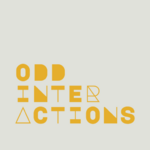OddInteractions: Unterschied zwischen den Versionen
Zwax (Diskussion | Beiträge) KKeine Bearbeitungszusammenfassung |
Paulf (Diskussion | Beiträge) KKeine Bearbeitungszusammenfassung Markierungen: Mobile Bearbeitung Mobile Web-Bearbeitung |
||
| (12 dazwischenliegende Versionen von 8 Benutzern werden nicht angezeigt) | |||
| Zeile 3: | Zeile 3: | ||
{{Veranstaltung | {{Veranstaltung | ||
|name=Odd Interactions Workshop | |name=Odd Interactions Workshop | ||
|image= | |image=Odd_interactions_logo.png | ||
|involved=https://www.saramlakar.com | |involved=https://www.saramlakar.com | ||
|when=29.06.2025, 14:00 | |when=29.06.2025, 14:00 | ||
| Zeile 9: | Zeile 9: | ||
|category=Workshop | |category=Workshop | ||
|status=active | |status=active | ||
|wtf= | |wtf=playful and exploratory HCI design practice in development | ||
|hidden=false | |hidden=false | ||
}} | }} | ||
Odd Interactions is a playful and exploratory HCI design practice in development. The practice aims to expand the possibilities of interaction design at early development stages, uncovering potentially more appropriate, though unconventional, ways to interact with technology. Inspired by my work with smart textile interfaces, this methodology responds to a limitation I've observed in traditional HCI, where familiar surface gestures that prioritize efficiency often overlook the unique properties and potential of the medium itself. Instead, the process of Odd Interactions allows us to discover overlooked opportunities that may make interactions more secure, accessible, critical, representative of a specific technology, exposing the limits of technology, or nudging behaviour. | |||
{| class="wikitable" | |||
|+ Participants | |||
|- | |||
! name !! yes/maybe !! notes | |||
|- | |||
| becca || maybe|| | |||
|- | |||
|[[Benutzer:Navi|Navi]] | |||
|yes | |||
| | |||
|- | |||
|seba | |||
|maybe | |||
| | |||
|- | |||
|[[Benutzer:Zwax|zwax]] | |||
|yes | |||
| | |||
|- | |||
|[[Benutzer:sqwischi|sqwischi]] | |||
|yes | |||
| | |||
|- | |||
|totientfunction | |||
|yes | |||
| | |||
|- | |||
|ncl | |||
|yes | |||
| | |||
|- | |||
|[[Benutzer:Paulf|Paulf]] | |||
|yes | |||
| | |||
|- | |||
| you? || yes/maybe || | |||
|} | |||
Aktuelle Version vom 29. Juni 2025, 12:07 Uhr
| Language: | English |
|---|
| Odd Interactions Workshop | |

| |
| 29.06.2025, 14:00 | |
| Hauptraum | |
| https://www.saramlakar.com | |
| Workshop | |
| active | |
| playful and exploratory HCI design practice in development | |
| Zuletzt aktualisiert: | 29.06.2025 |
Odd Interactions is a playful and exploratory HCI design practice in development. The practice aims to expand the possibilities of interaction design at early development stages, uncovering potentially more appropriate, though unconventional, ways to interact with technology. Inspired by my work with smart textile interfaces, this methodology responds to a limitation I've observed in traditional HCI, where familiar surface gestures that prioritize efficiency often overlook the unique properties and potential of the medium itself. Instead, the process of Odd Interactions allows us to discover overlooked opportunities that may make interactions more secure, accessible, critical, representative of a specific technology, exposing the limits of technology, or nudging behaviour.
| name | yes/maybe | notes |
|---|---|---|
| becca | maybe | |
| Navi | yes | |
| seba | maybe | |
| zwax | yes | |
| sqwischi | yes | |
| totientfunction | yes | |
| ncl | yes | |
| Paulf | yes | |
| you? | yes/maybe |